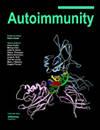A novel circRNA, circRACGAP1, hampers the progression of systemic lupus erythematosus via miR-22-3p-mediated AKT signalling
IF 3.3
4区 医学
Q3 IMMUNOLOGY
引用次数: 4
Abstract
Abstract Background Systemic lupus erythematosus (SLE) is defined as a multisystem autoimmune disease involving various organs, of which exact molecular mechanisms remain elusive. Here, we aimed to investigate a novel circular RNA (circRNA), circRACGAP1, abnormally expressed in SLE and explored its underlying regulatory network. Methods The expression patterns of circRACGAP1 were determined in patients diagnosed with SLE by using a qRT-PCR assay. Spearman correlation analysis was employed to evaluate the correlation between circRACGAP1 and clinicopathological variables in patients with SLE. Flow cytometry and TUNEL assays were subjected to assess the cell apoptosis. Nuclear-cytoplasmic fractionation and luciferase reporter assay was used to verify the circRACGAP1/miR-22-3p/PTEN axis. Western blot analysis was performed to measure the PTEN/AKT signalling-related proteins and apoptotic-related biomarkers. Results Down-regulated circRACGAP1 was observed and correlated with Systemic Lupus Erythematosus Disease Activity Index (SLEDAI) score, anti-double-stranded (ds) DNA, and complement C3 level in patients with SLE. Overexpression of circRACGAP1 significantly alleviated cell apoptosis in Jurkat cells within UVB exposure. Mechanistic investigation revealed that circRACGAP1 could serve as a sponge of miR-22-3p to regulate PTEN/AKT signalling. Conclusions Collectively, circRACGAP1 regulated the AKT signalling pathway via binding to miR-22-3p in the progression of SLE, suggesting therapeutic targets for SLE treatment.一种新的circRNA circRACGAP1通过mir -22-3p介导的AKT信号传导阻碍系统性红斑狼疮的进展
系统性红斑狼疮(SLE)是一种涉及多器官的多系统自身免疫性疾病,其确切的分子机制尚不清楚。在这里,我们旨在研究一种新的环状RNA (circRNA), circRACGAP1,在SLE中异常表达,并探索其潜在的调控网络。方法采用qRT-PCR检测SLE患者circRACGAP1的表达谱。采用Spearman相关分析评价circRACGAP1与SLE患者临床病理变量的相关性。流式细胞术和TUNEL法检测细胞凋亡情况。采用核细胞质分离和荧光素酶报告基因法验证circRACGAP1/miR-22-3p/PTEN轴。Western blot检测PTEN/AKT信号相关蛋白和凋亡相关生物标志物。结果circRACGAP1下调与系统性红斑狼疮疾病活动指数(SLEDAI)评分、抗双链DNA (ds)和补体C3水平相关。circRACGAP1过表达可显著减轻UVB暴露下Jurkat细胞的凋亡。机制研究显示circRACGAP1可以作为miR-22-3p的海绵调节PTEN/AKT信号传导。综上所示,circRACGAP1在SLE的发展过程中通过与miR-22-3p结合调控AKT信号通路,提示SLE治疗的靶点。
本文章由计算机程序翻译,如有差异,请以英文原文为准。
求助全文
约1分钟内获得全文
求助全文
来源期刊

Autoimmunity
医学-免疫学
CiteScore
5.70
自引率
8.60%
发文量
59
审稿时长
6-12 weeks
期刊介绍:
Autoimmunity is an international, peer reviewed journal that publishes articles on cell and molecular immunology, immunogenetics, molecular biology and autoimmunity. Current understanding of immunity and autoimmunity is being furthered by the progress in new molecular sciences that has recently been little short of spectacular. In addition to the basic elements and mechanisms of the immune system, Autoimmunity is interested in the cellular and molecular processes associated with systemic lupus erythematosus, rheumatoid arthritis, Sjogren syndrome, type I diabetes, multiple sclerosis and other systemic and organ-specific autoimmune disorders. The journal reflects the immunology areas where scientific progress is most rapid. It is a valuable tool to basic and translational researchers in cell biology, genetics and molecular biology of immunity and autoimmunity.
 求助内容:
求助内容: 应助结果提醒方式:
应助结果提醒方式:


